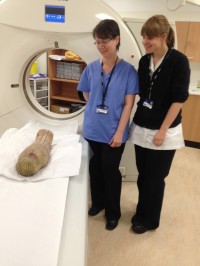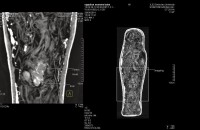 CT scans have revealed that a small cartonnage sarcophagus in the Wellcome collection at Swansea University’s Egypt Centre contains the mummified remains of a three to four-month-old fetus.
CT scans have revealed that a small cartonnage sarcophagus in the Wellcome collection at Swansea University’s Egypt Centre contains the mummified remains of a three to four-month-old fetus.
The sarcophagus is just over 20 inches long and painted in the style of the 26th Dynasty (ca. 600 B.C.), with a yellow and blue wig, wide collar, and brick red face. The body features crossing diagonal lines that form diamond shapes with a cream vertical band from collar to feet and two horizontal bands intersecting it. On the bands are painted hieroglyphics that don’t make any sense. Because of this, there have been some questions its authenticity but it’s not unheard of for genuine sarcophagus from this period to have gibberish hieroglyphics. Pioneering Egyptologist Sir William Matthew Flinders Petrie posited that the painters of mock hieroglyphics may have been illiterate and included the nonsense words because the presence of hieroglyphics was important for the voyage to the afterlife. The provenance of the piece can’t help because all we know about it is that it entered the collection in 1971.
 In 1998, Singleton Hospital X-rayed the sarcophagus and found traces of what could be a small skull, but nothing conclusive. On April 28th of this year, Swansea Univerity’s Clinical Imaging College of Medicine CT scanned the sarcophagus which revealed far more details about what’s inside. The bulk of the space is filled with folded textile, likely linen bandages.
In 1998, Singleton Hospital X-rayed the sarcophagus and found traces of what could be a small skull, but nothing conclusive. On April 28th of this year, Swansea Univerity’s Clinical Imaging College of Medicine CT scanned the sarcophagus which revealed far more details about what’s inside. The bulk of the space is filled with folded textile, likely linen bandages.
Within those folded strips of material, the CT scan showed a darker area about 3 inches long which researchers identified as a fetus in fetal position and with a placental sac. What could be the fetus’s femur was also identified.
“The length of the femur together with the size of the dark patch is consistent with that of a 12 to 16-week-old fetus,” Graves-Brown said.
“Another dark patch suggests the presence of an amulet and there are several areas with dark circles resembling strings of beads or tassels,” she added.
 Strings of beads are fairly common in mummy wrappings from the 26th Dynasty.
Strings of beads are fairly common in mummy wrappings from the 26th Dynasty.
The CT scan could not determine the gender of the fetus. The iconography of the sarcophagus suggests he was a boy. The striped wig was typically used on the sarcophaguses of men (although women were known to sport them as well) and the russet face paint is characteristic of male burials.
Fetus coffins are rare but not unheard of. There were two fetuses found in Tutankhamun’s tomb, and a whole section of the Eastern cemetery in Deir el-Medina was dedicated to the burial of children, fetuses and placentas. Egyptians believed the placenta was a twin of the self, so when a fetus or stillbirth was buried, the placenta was buried too.
What’s the dna haplogroup ? R1b probably.